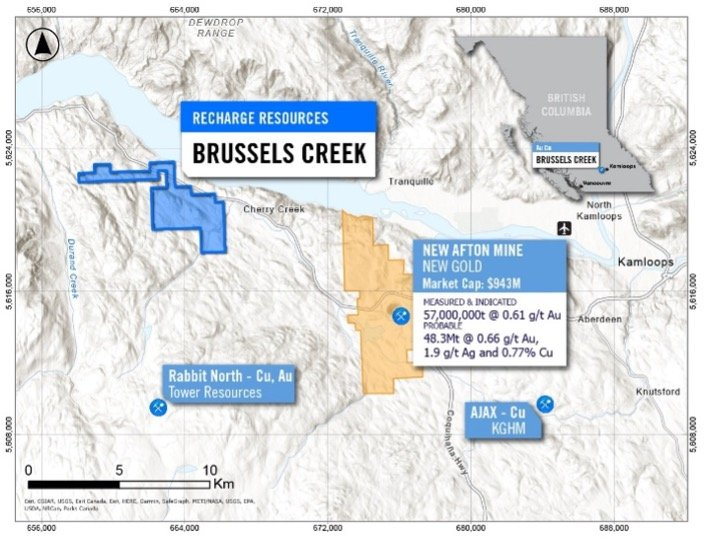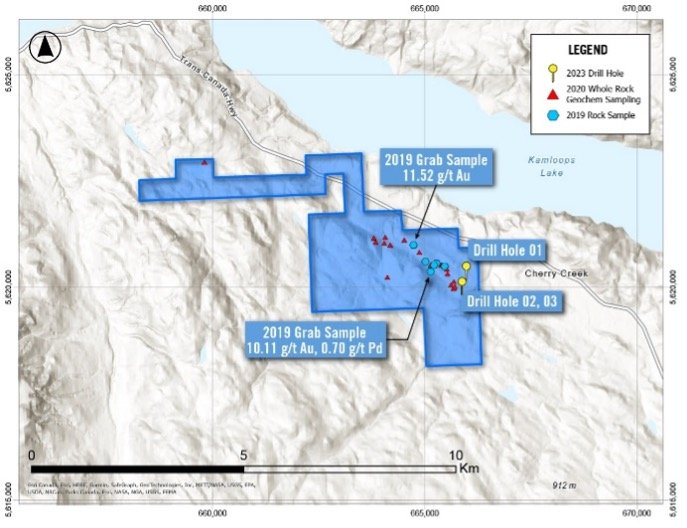Archive
Recharge Makes New Gold Discovery at Brussels Creek Project with Drilling Pending at the Pocitos Lithium Brine Project
 | |||||||||
 |  |  | |||||||
Vancouver, BC - TheNewswire - June 6, 2023 - Recharge Resources Ltd. (“Recharge” or the “Company”) (RR:CSE) (RECHF:OTC) (SL50:Frankfurt) announced today that all assays have been received on its fully-funded, spring drill program at its 100% owned Brussels Creek Gold-Copper-Palladium Project in Kamloops, BC, Canada. A new near surface discovery has been made of a gold zone from 25.75m to 29.25m (3.5m) assaying 5.08 g/tonne gold.
The aim of the 900-meter NQ drill program was to test the potential for copper-gold mineralization similar to that present at the adjacent New Afton mine owned by New Gold Inc. NGD.V ($1.18 Billion Market Cap). The New Afton Mine occupies the site of the historic Afton Open Pit mine, which operated from 1977 to 1997. The present mine and concentrator facility commenced production in July 2012. The mine is a block caving operation. In 2021, the mine produced 52,542 oz Au and 61,700,000 lbs Cu.

Fig. 1 Brussels Creek location and proximity to New Afton Mine

Fig. 2 2019 sampling and 2023 drill hole locations
CEO, David Greenway, summarised, “Recharge is pushing forward on all fronts with drilling at the Brussels Creek Copper-Palladium-Gold Project. Future work will zero in on large geophysical and geochemical anomalies near the new gold zone. Drilling is pending at the Pocitos lithium brine project and a Spring recon program now approved for the Georgia Lake Lithium project.
“We thank Mr. Shearer and all those involved in the consultation and drill planning process. Recharge is committed to sustainable exploration and mining practices. This is a pivotal time for the Brussels Creek Project in BC, with the drill program successfully indicating a significant bedrock gold zone.”
Brussels Creek Project
The BC property is an early-stage exploration property, located approximately 24 kilometres west of Kamloops, and is immediately adjacent to New Gold’s New Afton mine. The property has 17 claims (66 cells) covering 1,350.43 hectares. The geological setting of the property is very similar to New Afton, a silica-saturated copper-gold alkalic porphyry-style deposit, as well as the Highland Valley, Mount Polly, Kemess and Galore Creek deposits. Recent field observations noted the presence of a substantial mineralized quartz-feldspar porphyry body intruding the overlying Nicola group volcanics. Historic sampling and mapping on the property, in 1983 and 1984, located a broad anomalous zone (200 metres by 400 metres) with gold values up to 3.5 grams per tonne. Grab samples taken from the property in 2019 include values of 10.1 g/t Au (with 0.7 g/t palladium) and 11.5 g/t Au.
The interval that ran 7.44 g gold came back in the quartered core as 16.35 g Au between 28.75m and 29.25m.
Over the 3.5 meters from 25.75m and 29.25m the quartered core averaged 5.08 grams per tonne. Gold mineralization starts at the overburden-bedrock contact.
This gold zone is hosted by quartz-feldspar porphyry intrusive likely associated with the Iron Mask plutonic suite. The mineralized zone is characterized by pervasive quartz sericite alteration with overprinting by clay-carbonate stockworks containing pyrite and sphalerite along with traces of chalcopyrite and galena.
The Property is largely underlain by a northwest trending, moderately southwest dipping sequence of andesitic volcaniclastic rocks and siltstones of the Upper Triassic Nicola Group. Some massive, well-indurated andesitic flows, flow breccias and agglomerates (Nicola Group) also occur. The Nicola rocks are cut by later porphyritic rhyolitic dikes, sills and plugs that are possibly related to the Iron Mask Plutonic Suite or younger rocks.
The area drilled focussed on the southeast eTh/K anomaly coincident with strong IP response. Future work will zero in on the eTh/K anomaly A to the northwest of the 2023 drilling once archaeological studies are completed. Comparison of the gamma-ray spectrometry included in the two public domain surveys indicates notable eTh/K anomalies spatially correlating to identified zones of magnetic disruption and complex structure. The low eTh/K “areas of interest” may be delineating enhanced alteration. The ADUF mineral showing in particular is adjacent to Anomaly A, proving encouragement for further investigation.
In these areas of anomalous gold, the rhyolitic rocks are quartz-sericite altered and country rocks are strongly altered to an assemblage of carbonate (ankerite and calcite), quartz, with sericite near the dike contacts and grading to chlorite further away. Outside of this zone, calcite, chlorite and locally epidote are predominant as a propylitic halo. As much as 5 per cent disseminated pyrite occurs in the altered rhyolite dike rock and adjacent carbonate altered andesitic volcaniclastic. Limonite after pyrite occurs as films on some fractures and as seams and blebs associated with quartz-calcite veins, and opaline silica veins.
As reported in the 1985 Assessment Report (#13877), anomalous gold values (85 to 3500 ppb) are localized in and about some of the smaller north-northwesterly trending porphyry rhyolite dikes that cut the andesitic volcaniclastics and related siltstones. This zone is oriented NNW-SSE and is about 400m long and up to 200m wide. In these areas of anomalous gold, the rhyolitic rocks are quartz-sericite altered and country rocks are strongly altered to an assemblage of carbonate (ankerite and calcite), quartz, with sericite near the dike contacts and grading to chlorite further away.
Outside of this zone, calcite, chlorite and locally epidote are predominant as a propylitic halo. As much as 5 per cent disseminated pyrite occurs in the altered rhyolite dike rock and adjacent carbonate altered andesitic volcaniclastic. Limonite after pyrite occurs as films on some fractures and as seams and blebs associated with quartz-calcite veins, and opaline silica veins.
XRF assays throughout the 3 drill holes show high potassic alteration. Complex faulting and shearing was evident towards the bottom of holes 2 and 3. Highly siliceous and sheared feldspar-quartz porphyry was observed near the end of hole 2.
Brussels Creek Web Page: https://recharge-resources.com/projects/brussels-creek/
Recharge’s management cautions that past results or discoveries on properties in proximity to Recharge may not necessarily be indicative of the presence of mineralization on the Company’s properties.
The core was carefully sawn with a diamond saw and put in plastic bags under lock and key until they were delivered, in person, to ALS Labs in North Vancouver by J.T. Shearer. ALS Labs is a globally certified lab. Standards and blanks were inserted into the sample stream.
Qualified Person
Johan T Shearer, P. Geo., Consulting Geologist, is the qualified person as defined by NI 43-101 responsible for the technical content of this release, and consents to its release.
About Recharge Resources
Recharge Resources is a Canadian mineral exploration company focused on exploring and developing the production of high-value battery metals to create green, renewable energy to meet the demands of the advancing electric vehicle and fuel cell vehicle market.
All stakeholders are encouraged to follow the Company on its social media profiles on LinkedIn, Twitter, Facebook and Instagram.
On Behalf of the Board of Directors,
“David Greenway”
David Greenway, CEO.
For further information, please contact:
Recharge Resources Ltd.
Joel Warawa
Phone: 778-588-5473
E-Mail: info@recharge-resources.com
Website: recharge-resources.com
Neither the Canadian Securities Exchange nor its Regulation Services Provider (as that term is defined in the policies of the CSE) accepts responsibility for the adequacy or accuracy of this release.
Disclaimer for Forward-Looking Information
Certain statements in this release are forward-looking statements, which reflect the expectations of management regarding Recharge’s intention to continue to identify potential transactions and make certain corporate changes and applications. Forward looking statements consist of statements that are not purely historical, including any statements regarding beliefs, plans, expectations or intentions regarding the future. Such statements are subject to risks and uncertainties that may cause actual results, performance or developments to differ materially from those contained in the statements. No assurance can be given that any of the events anticipated by the forward-looking statements will occur or, if they do occur, what benefits Recharge will obtain from them. These forward-looking statements reflect managements’ current views and are based on certain expectations, estimates and assumptions which may prove to be incorrect. A number of risks and uncertainties could cause actual results to differ materially from those expressed or implied by the forward-looking statements, including Recharge’s results of exploration or review of properties that Recharge does acquire. These forward-looking statements are made as of the date of this news release and Recharge assumes no obligation to update these forward-looking statements, or to update the reasons why actual results differed from those projected in the forward-looking statements, except in accordance with applicable securities laws.